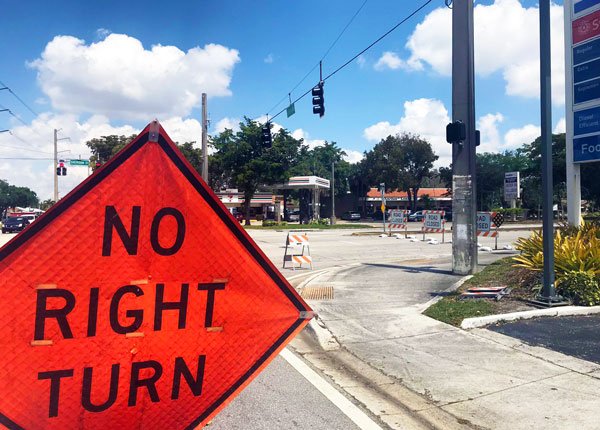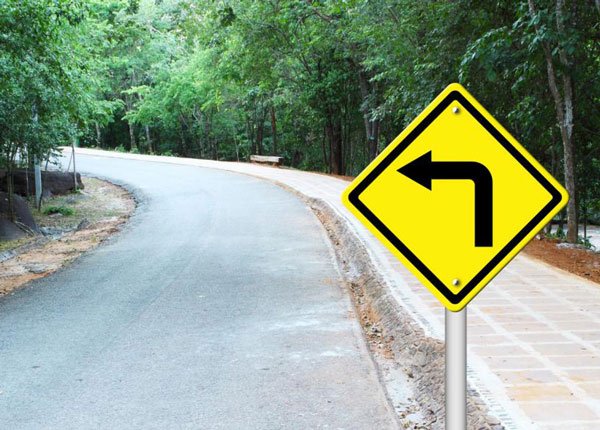
Turning Right: Signalling, Right Turn on Red, Choosing The Lane
Updated Oct. 30, 2020While all course changes require knowledge and skill, making a right turn is easier, safer and more straight-forward than making a left turn. When turning right you do not need to worry about traffic traveling in the opposite direction from the road you are entering, which makes things a whole lot simpler. In some areas you can even turn right against a red traffic signal (check your state’s driving manual for information).
Easy though it may be, making right turns is a skill you must master before taking on the driving test. Here, we break down the process of making a right turn and discuss how it applies in different traffic situations.
How to make a right turn
- 1

Plan and prepare.
Anticipate your right turn and make sure you are in the correct lane soon enough to maneuver. Avoid making last-minute lane changes as your vehicle will become a hazard for other drivers. Assume lane position three in preparation for your right turn, aligning your vehicle a few inches away from the right-hand lane divide markings. - 2

Signal your intention to turn right.
This should be done well in advance of the turn so that other drivers are not forced to react at the last moment. Most state handbooks specify that turns should be indicated at least 100 feet in advance and that signal lights should remain active until the maneuver is complete. Use the right turn hand signal (left arm extended out the left window, arm bent at the elbow and forearm pointing upward) if your turn signals are broken or obscured. - 3

Reduce speed and check for cyclists and motorcyclists.
Turn to check your vehicle’s blind spots in addition to using your mirrors, as bicycles and motorcycles can easily be hidden in these areas. Like any other vehicle, cyclists and motorcyclists have the right-of-way in this situation. - 4

Check for “STOP” or “YIELD” signs at the intersection and abide by their instructions.
If a “YIELD” sign is present, you must slow down and allow cross-traffic and pedestrians the right-of-way. A “STOP” sign means that you must come to a complete stop to yield the right-of-way. - 5

Look for traffic lights controlling the intersection.
You may turn right if the signal light is green or if the turn is protected, with a green arrow signal. You may usually make a right turn against a red signal light but only after coming to a complete stop. If a “NO TURN ON RED” traffic sign or a red arrow pointing in the direction of the turn are present, you cannot make the right turn. - 6

Check for pedestrians crossing the street.
You MUST yield to pedestrians, at all times. - 7

Check for traffic in both directions before turning right.
Only turn when you are certain it is safe and do not swing your vehicle wide during or prior to the turn. - 8

Finish your turn in the same lane.
Changing lanes at an intersection is usually dangerous and sometimes illegal. Check your state's driving manual to find out if intersection lane-changes are prohibited in your state.
The number of directions in which traffic is moving may affect how you should execute a right turn. Different procedures should be followed on one-way and two-way streets, as detailed below:
From a one-way street into a one-way street:
If turning right from a one-way street into another one-way street, you should move into the furthest right lane as early as possible and remain there during the turn. In some cases, you may notice a lane marked “LANE USE CONTROL” accompanied by directional pavement markings. This indicates that more than one lane may be used to turn right into that street.
From a one-way street into a two-way street:
Follow the same steps outlined above when turning right from a one-way street into a two-way street. Assume a position in the right-hand lane unless signs and pavement markings indicate that other lanes may be used. Choose a lane marked “RIGHT TURN ONLY” over one marked “STRAIGHT OR RIGHT TURN” whenever possible, to avoid holding up traffic moving straight over the intersection.
From a two-way street into a two-way street:
You must always turn from the right-hand lane and remain there, when turning right from a two-way street to a two-way street. Motorists traveling from the opposite direction may intend to turn into the same street at the same time, in which case changing lanes during the turn could cause an accident.
Right Turn on a Red Traffic Signal
Drivers are permitted to make right turns through a red traffic signal in most states; this information can be found in your state’s driving manual. However, when turning right on a red traffic signal, you must treat the red light like a “STOP” sign. In this situation, drivers must come to a complete stop before the signal or stop line, yielding to cross-traffic and pedestrians using the crosswalk. Make sure there are no motorcyclists or cyclists close to your vehicle – particularly on the right side – before executing the turn.
It will be quite clear when making a right turn is not permitted. This may be indicated with a red arrow signal light pointing to the right.
In other situations, a “NO TURN ON RED” sign will be displayed. When one of these signs or a red right-facing arrow is present, you must not turn right until the signal light has turned green.
 The “no turn on red” sign is used at some intersections to notify drivers that a right turn on a red light or a left turn on a red light at intersecting one-way streets is prohibited. The sign may also show a red circle instead of the word red.
The “no turn on red” sign is used at some intersections to notify drivers that a right turn on a red light or a left turn on a red light at intersecting one-way streets is prohibited. The sign may also show a red circle instead of the word red.



